How to send a letter via Russian Post: step-by-step instructions
With the development of postal services on the Internet and accessible services from cellular operators, paper postcards and letters in envelopes are no longer sent as often as 10-15 years ago. But in some cases it is impossible to do without sending it in a regular postal envelope. How to send a letter via Russian Post so that the correspondence is guaranteed to reach the addressee?
What can you send in a postal envelope?
To begin with, it is worth determining what exactly can be sent in an envelope for letters, and for what you will need to use, for example, a parcel. What can you send by letter by Russian Post?
In addition to postcards and letters, you can put almost any paper or cardboard correspondence in the envelope: personal documents (passport, diploma, work book, certificates, etc.), paper (cardboard) crafts and products, photographs, etc. The main thing is that the weight of one letter did not exceed the established norm - 100 g (for letters to another country - no more than two kilograms). The exception to this rule is money and bank cards - postal workers themselves do not recommend putting them in envelopes.
The question often arises: is it possible to enclose small objects in a paper letter? For example, jewelry, keychains, flat magnets, badges? Postal employees answer this question in the negative. The reason is simple - when stamping an envelope or when sending/removing it through a mailbox, the envelope may tear due to the bulky item inside.
However, senders who have had some success sending small items in letters claim that such attachments can be transported as long as the items cannot be clearly felt in the envelope. This is achieved by simply wrapping the item in cardboard, several layers of tape or thick paper.
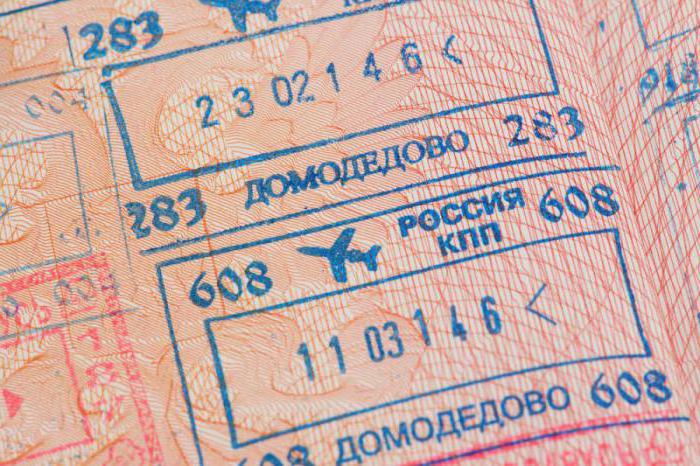
How to send a simple letter
Depending on the type of sending, letters can be registered, simple, express, letters with declared value or with notification. The step-by-step procedure for sending them is approximately the same, with the exception of some features. Using the example of a simple postal item, let's look at how to send a letter via Russian Post:
- Any letter is sent from the nearest Russian Post office, the address of which can be found on the official website of this organization. A simple letter, in addition, can be dropped into a street mailbox.
- To send, you need to purchase an envelope in accordance with the size of the attachment. The smallest is 114 x 162 mm or 110 x 220 mm (euro), the largest is 229 x 324 mm.
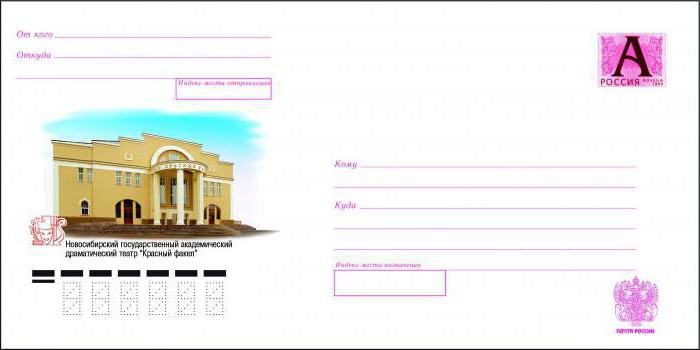
- The envelope should be filled out in legible handwriting in any color of ink except red, yellow and green. Various crossing-outs, stains or corrections on the envelope are not allowed.
- In the upper left corner, in a special field, fill in information about the sender:
- in the line “From” the full name or name of the sending organization is indicated;
- in the “From” lines, enter the sender’s address data in the following order:
- Street;
- House number;
- building number (if any);
- apartment number (office or office number);
- settlement (full geographical name);
- district (if it is present in the address);
- name of the region of the Russian Federation (region, territory, etc.);
- name of the country of departure (only for sending abroad);
In the lower window, fill in 6 digits corresponding to the sender's post office index.
- In the same order, information about the recipient of the letter is entered into the lines of the field located in the lower right corner of the envelope.
- In the field for the digital index (lower left corner), the recipient's post office index is entered along the contour.
- After filling out all the required fields, an attachment (letter, postcard, etc.) is placed inside the envelope and the envelope is sealed.
A simple letter, the weight of which does not exceed 20 g, is sent in a postal envelope without additional payment or additional stamps. However, if the weight of the item is greater or the letter is expected to be delivered outside the country, then before sending the letter via Russian Post, you should contact the operator, who will weigh the letter and affix stamps in accordance with the price of the item.
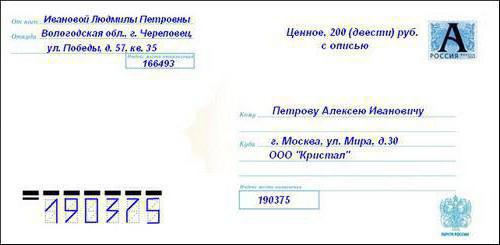
How to send a registered letter
How does such a message differ from a simple letter? How to send a registered letter via Russian Post? The service for sending registered letters is intended for sending important documentation, official correspondence (requests, claims, notifications, complaints, etc.). Registered letters have a number of advantages compared to sending a simple message:
- When sent, a registered letter is assigned an individual track number (indicated at the top of the check issued to the sender). Using it, it is possible to track the delivery of the message through the Internet service “Tracking of items” on the PR website.
- This type of shipment is delivered personally to the addressee against signature after presentation of the passport. This is indisputable evidence that the sender sent the letter in a timely manner, and the recipient is familiar with the contents of the message.
Sending registered mail is a more reliable, but also more expensive way of delivering correspondence. How to send a letter via Russian Post if you need to use the “Registered Letter” service? After completing the steps described above, the sender must contact the postal operator, say that he needs to send a registered letter, and pay the cost of this service. The postal employee will weigh the envelope, register the letter with a tracking number, and attach a barcode and stamps in accordance with the cost of the item.

Notice: what is it for and how to fill it out correctly
Registered letters with notification are a service that allows the sender to find out the exact date of delivery of the letter to the recipient. This is an official document, which in some cases can also serve as proof of the fact that correspondence was sent on time. To use this service, you must fill out a form and inform the operator that a registered letter is sent with a notification.
It is filled out on a special postal form F-119. All information is on both sides in a field indicating: “Those circled with a bold line are filled in by the sender.” The filling procedure is as follows:
- In the field indicating “Notification must be returned to the address”, the data of the sender of the letter is entered in the same sequence as on the envelope. Marks are placed in the “Letter” and “Registered” boxes.
- The recipient's details are entered in the field on the back of the form, in the same order as on the envelope. Marks are placed in the “Letter” and “Registered” boxes.
- The notification is glued by the operator directly to the envelope, and after delivering the registered letter to the recipient, the form is removed by the postman and sent to the sender.
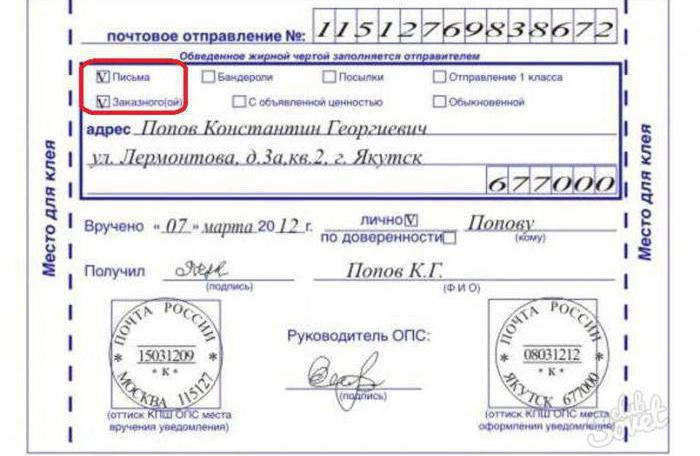
Letter with a description of the attachment
It is recommended to order a letter of value (also known as a letter of declared value) to send particularly valuable attachments: originals of personal documents, securities, real estate documentation, etc. This type of postal item is supplemented by a description of the attachment indicating the amount at which the sender estimates the contents of the envelope.
This type of forwarding is considered one of the most reliable, since a valuable letter is necessarily assigned a registration number, which means it can be tracked on its way to the addressee. In addition, if the letter is suddenly lost, the sender receives compensation from the post office in the amount of the declared value.
How to send a registered letter via Russian Post if it needs to be supplemented with an inventory of the attachment with a declared value? In addition to purchasing and filling out the envelope (there is no need to seal the letter), the sender will need to contact the post office operator to make an inventory:
- It is filled out by the sender in duplicate on special forms f-107. The inventory must contain a detailed list of all papers sent in the letter, indicating their estimated value.
- The mail operator checks the contents of the attachment with the compiled list.
- Each copy is signed by the operator who accepted it and the sender.
- One copy is handed over to the sender, the second is placed in an envelope along with the papers being sent.
How much does it cost to send a letter via Russian Post if it is a letter with declared value? In addition to the cost of sending a registered letter, the sender will need to pay insurance fees in the amount of 4% of the amount of its declared value. It is worth noting that in the event of its loss, the paid insurance fee will not be reimbursed to the sender.
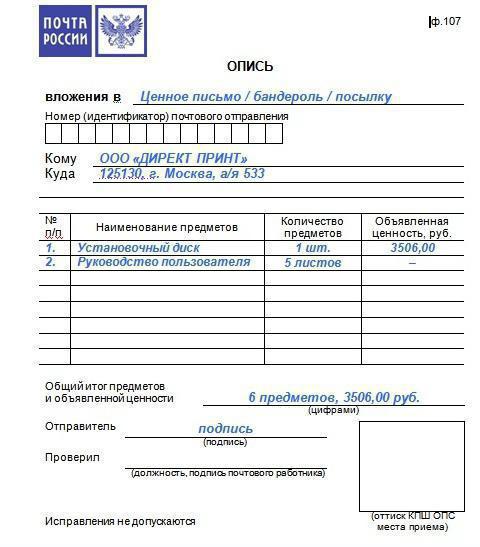
Cost of a letter
Mailing is the cheapest method of postal delivery. Today, the client has the opportunity to find out in advance how much it costs to send a letter via Russian Post. This can be done through the official website of Russian Post, using the Postal Calculator service.
For example, to find out how much it costs to send a registered letter by Russian Post, you need to enter information about the sender’s and recipient’s settlements into the interactive fields of the calculator, indicate the weight of the letter, the delivery method, and also check the box next to “Registered” in the “Additional Services” section. . After this, the service will automatically calculate the cost of sending.
